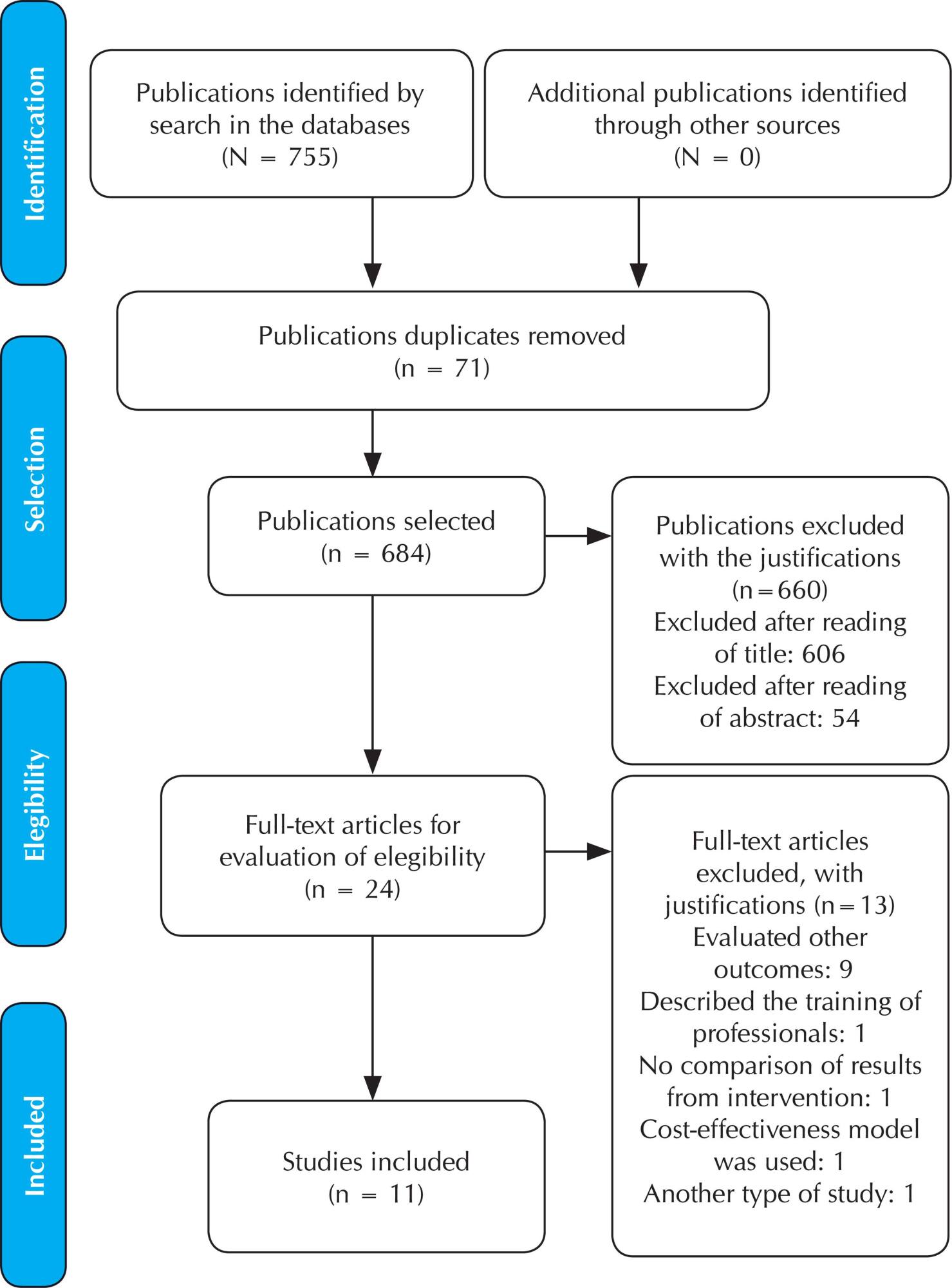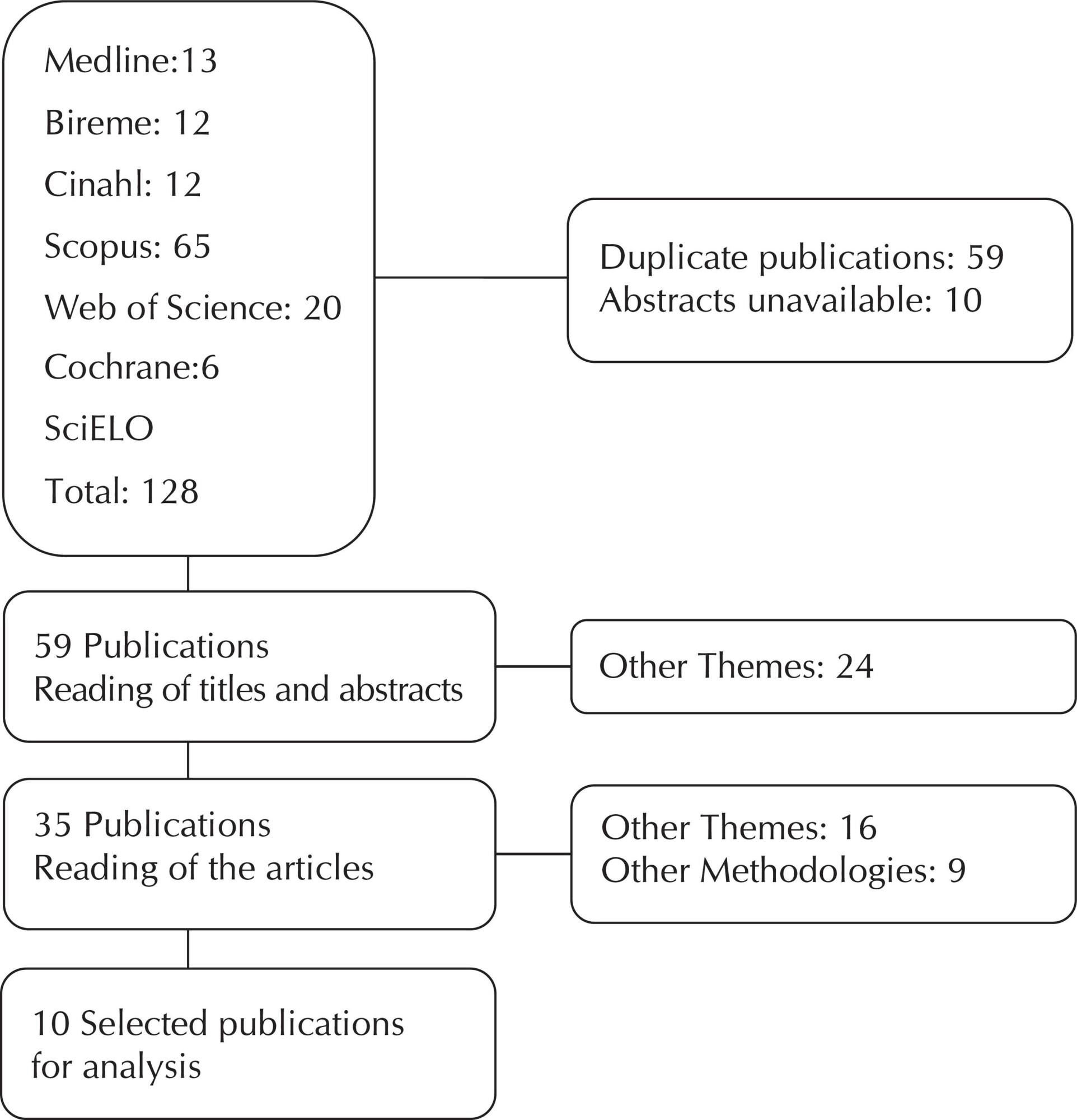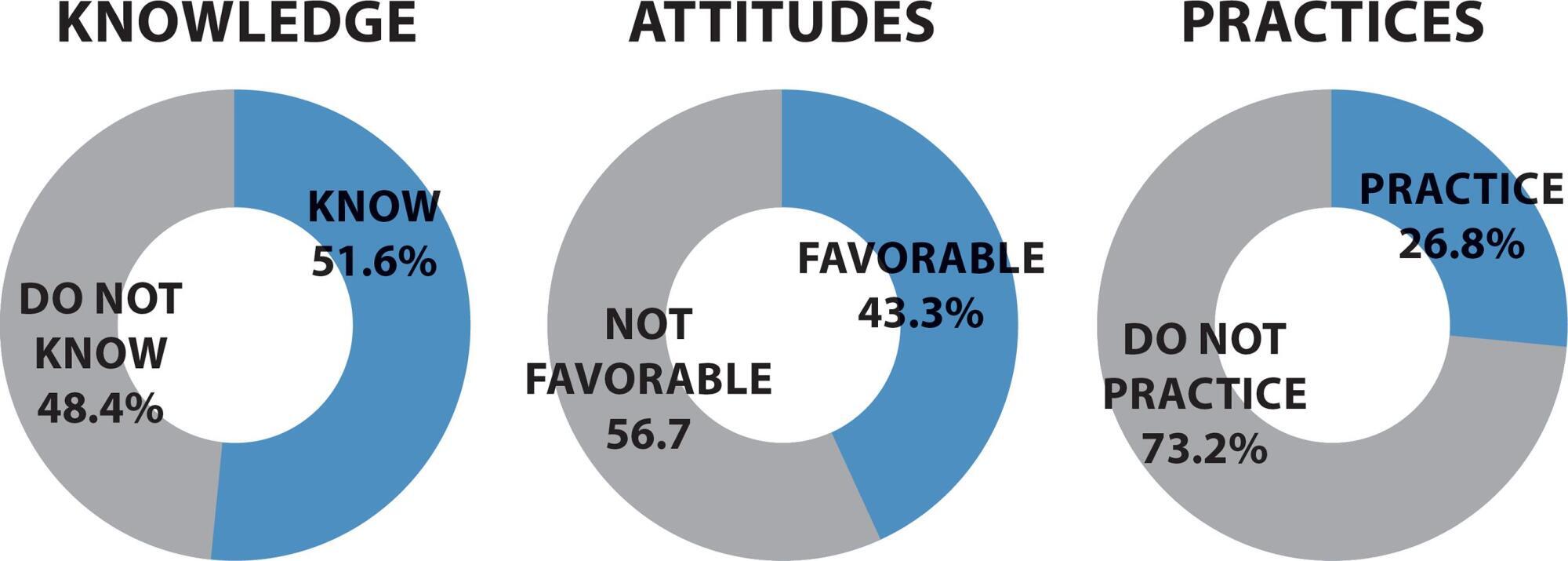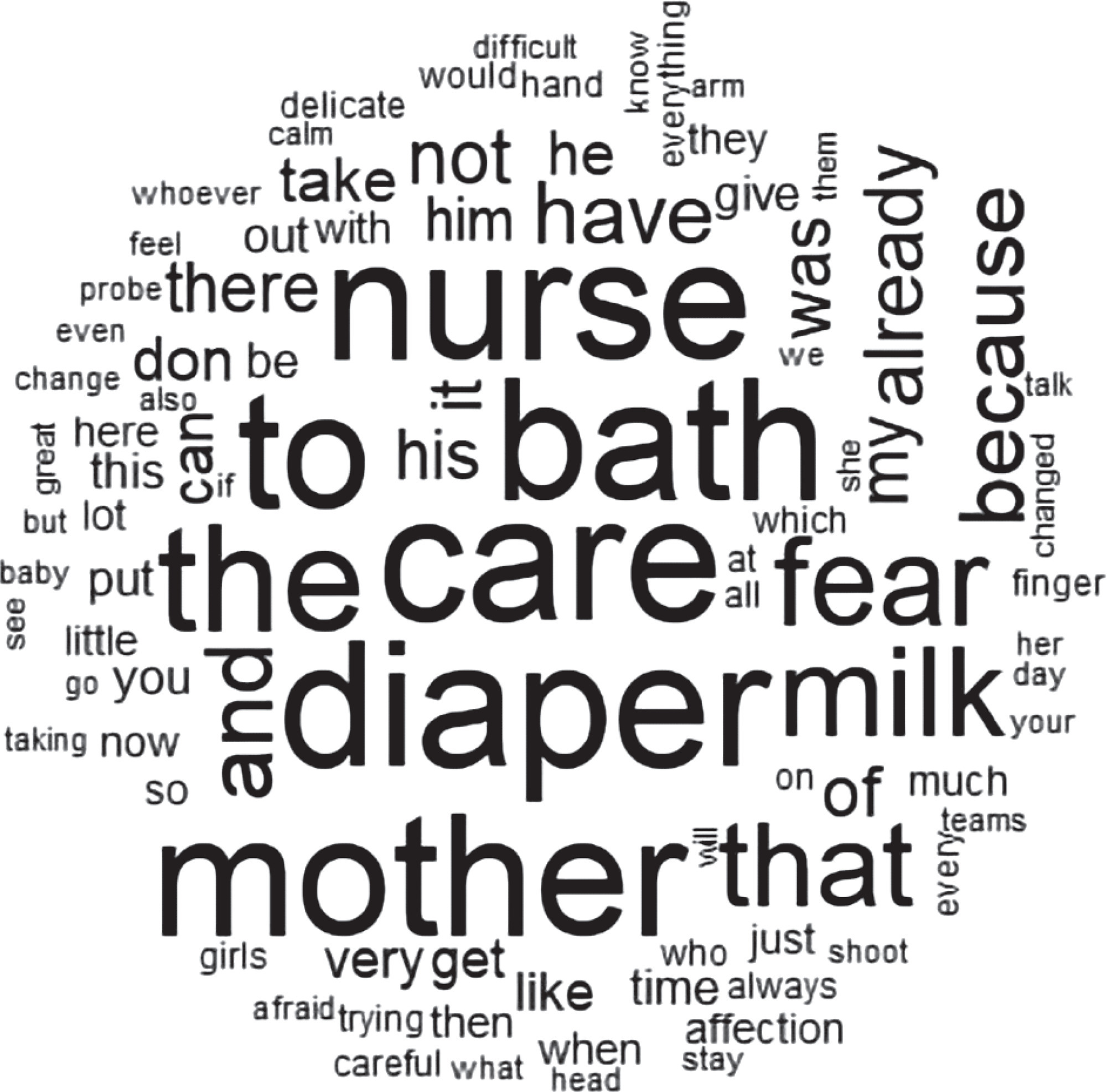-
REVIEW01-01-2016
Nursing diagnoses in patients with cerebral vascular accident: an integrative review
Revista Brasileira de Enfermagem. 2016;69(4):785-792
Abstract
REVIEWNursing diagnoses in patients with cerebral vascular accident: an integrative review
Revista Brasileira de Enfermagem. 2016;69(4):785-792
DOI 10.1590/0034-7167.2016690423i
Views0See moreABSTRACT
Objective:
to verify the nursing diagnoses in patients affected by CVAs.
Method:
this is an integrative review of the literature. The search was conducted on LILACS, Scielo, Medline, CINAHL, and Scopus databases between February and March 2015, using the following keywords: “Enfermagem”, “Acidente Vascular Cerebral”, “Diagnóstico de Enfermagem”; and “Nursing”, “Stroke”, and “Nursing Diagnosis”.
Results:
we found 9 articles published between 2009 and 2015; most of them were Brazilian, cross-sectional, and exploratory, with a level of evidence of 6. The evidence from the publications was classified as: “Evaluation and validation of specific nursing diagnoses for subjects affected by CVAs” and “Application of the nursing process on subjects affected by CVAs”.
Conclusion:
we noticed the publications focused on nursing diagnoses related to motor disorders, such as risk of falls and impaired physical mobility. Domains regarding safety/protection (domain 11) and sleep/resting (domain 4) were present in most evaluated publications.
-
REVIEW01-01-2016
Impact of educational interventions in reducing diabetic complications: a systematic review
Revista Brasileira de Enfermagem. 2016;69(4):773-784
Abstract
REVIEWImpact of educational interventions in reducing diabetic complications: a systematic review
Revista Brasileira de Enfermagem. 2016;69(4):773-784
DOI 10.1590/0034-7167.2016690422i
Views0ABSTRACT
Objective:
To identify in the literature evidence of the effectiveness and efficacy of educational interventions in reducing metabolic and/or vascular complications in adults with diabetes mellitus.
Method:
A systematic review performed in LILACS, IBECS, CUMED, CINAHL and Medline databases and in the online library SciELO with studies published from 2004 to 2014.
Results:
Eleven studies were included (5 randomized clinical trials and 6 quasi-experimental). We only identified studies that analyzed vascular complications.
Conclusion:
Two clinical trials demonstrated efficacy in reducing cardiovascular complications, of cataract or retinopathy and nephropathy and all the quasi-experimental studies showed effectiveness in reducing feet ulcers, peripheral neuropathy and vasculopathy, and maintenance of kidney function.
Keywords:Diabetes Mellitus Type 1Diabetes Mellitus Type 2Diabetic ComplicationsEvaluation of the Efficacy-Effectiveness- of InterventionsHealth EducationSee more
-
REVIEW01-01-2016
The communication process in Telenursing: integrative review
Revista Brasileira de Enfermagem. 2016;69(4):765-772
Abstract
REVIEWThe communication process in Telenursing: integrative review
Revista Brasileira de Enfermagem. 2016;69(4):765-772
DOI 10.1590/0034-7167.2016690421i
Views0See moreABSTRACT
Objective:
to identify scientific evidence about the communication process in Telenursing and analyze them.
Method:
integrative review performed in March 2014. The search strategy, structured with the descriptors “telenursing” and “communication”, was implemented in the databases Medline, Bireme, Cinahl, Scopus, Web of Science, Scielo, and Cochrane.
Results:
ten studies were selected after inclusion and exclusion criteria. The main challenges were: the clinical condition of patients, the possibility for inadequate communication to cause misconduct, the absence of visual references in interactions without video, and difficulty understanding nonverbal communication.
Conclusion:
distance imposes communicative barriers in all elements: sender, recipient and message; and in both ways of transmission, verbal and nonverbal. The main difficulty is to understand nonverbal communication. To properly behave in this context, nurses must receive specific training to develop abilities and communication skills.

-
RESEARCH01-01-2016
Health care for patients with acute coronary syndrome according to quality indicators
Revista Brasileira de Enfermagem. 2016;69(4):757-764
Abstract
RESEARCHHealth care for patients with acute coronary syndrome according to quality indicators
Revista Brasileira de Enfermagem. 2016;69(4):757-764
DOI 10.1590/0034-7167.2016690420i
Views0ABSTRACT
Objective:
to assess in-hospital care for patients with Acute Coronary Syndrome according to quality indicators.
Method:
a longitudinal quantitative study was performed between November 2012 and March 2013 with 94 patients, including interviews and medical records.
Results:
a total of 39.4% of patients had unstable angina and 60.6% had myocardial infarction, of which 34% had ST segment elevation. Patients with TIMI and GRACE scores higher than four and 140 (p<0.05) respectively died. Admission to the intensive care unit totaled 2.1%; assessment of left ventricular (LV) ejection fraction, 83.0%; ASA within 24 hours of admission, 77.8%; statins, 72.7%; angiotensin-converting enzyme inhibitor, 62.8%; anti-smoking counseling, 53.3%; and timely reperfusion, 62.5%. Of all participants, 12.0% underwent an invasive strategy in 24h and 50.0% in 72h. Door-to-ECG time was 68.3±104.3 min and door-to-balloon time, 122±54.5 min.
Conclusions:
health care protocols are required to standardize practice and improve these indicators.
Keywords:Acute Coronary SyndromeEmergency Medical ServicesHealth Care QualityHealth Care Quality IndicatorsTreatment TimeSee more -
RESEARCH01-01-2016
Quality of working life of call-center workers
Revista Brasileira de Enfermagem. 2016;69(4):751-756
Abstract
RESEARCHQuality of working life of call-center workers
Revista Brasileira de Enfermagem. 2016;69(4):751-756
DOI 10.1590/0034-7167.2016690419i
Views0See moreABSTRACT
Objective:
to analyze the profile and quality of working life (QWL) of call-center workers.
Method:
quantitative research, conducted in one call-center of the city of São José do Rio Preto – SP, using the QVP-35 questionnaire.
Results:
profile was composed by: 80.2% women; 66.3% were single, with high school diploma and 6 hours of daily working hours; mean age of 28 years; 92.9% had only one job with mean working experience of 3 years. Positive aspects of QWL: intrinsic motivation, working ability, available resources and social support. Negative aspects of QWL: workload and organizational support.
Conclusion:
the data obtained indicate the need for better organization of call-center working processes in the company and suggests other researches in this context.
-
RESEARCH01-01-2016
Stressors perceived by patients in the immediate postoperative of cardiac surgery
Revista Brasileira de Enfermagem. 2016;69(4):741-750
Abstract
RESEARCHStressors perceived by patients in the immediate postoperative of cardiac surgery
Revista Brasileira de Enfermagem. 2016;69(4):741-750
DOI 10.1590/0034-7167.2016690418i
Views0See moreABSTRACT
Objective:
to investigate stressors perceived by patients in the immediate postoperative of cardiac surgery and their association with sociodemographic and clinical characteristics.
Method:
a prospective correlational study conducted in a city in São Paulo, between August 2013 and December 2014. A non-probabilistic sample included patients submitted to their first coronary artery bypass graft or mitral valve surgery. The “Environmental Stressor Questionnaire” adapted to Portuguese was used.
Results:
105 patients participated in the study. The item “being thirsty” was evaluated as the most stressful and “the nursing staff member does not introduce himself/herself by the name” as the least stressful. Among sociodemographic and clinical variables (gender, age, type and time of surgery, pain, intubation time, use of psychotropic medications and length of stay in the intensive care unit), only pain presented a significant association with the stressors.
Conclusion:
knowing stressors can help implement practices associated with their reduction, favoring patients’ recovery.
-
RESEARCH01-01-2016
Concepts and practices of teaching and exercise of leadership in Nursing
Revista Brasileira de Enfermagem. 2016;69(4):733-740
Abstract
RESEARCHConcepts and practices of teaching and exercise of leadership in Nursing
Revista Brasileira de Enfermagem. 2016;69(4):733-740
DOI 10.1590/0034-7167.2016690417i
Views0ABSTRACT
Objective:
to identify, describe and analyze characteristics of leadership, head nurses and participants in the teaching-learning process of leadership in Nursing, according to nurse professors who performed studies on this theme and taught such content between 1972 and 1994 in nursing schools of the state of São Paulo, southeastern Brazil.
Methods:
Thematic Oral History was used. A total of four nurse professors were interviewed, whose reports were submitted to content analysis.
Results:
the following aspects were approached in this study: the context in which students developed leadership, the influence of previous experiences on leadership qualification, its attributes, the importance of leadership, the value of teaching it, the possibilities of emancipation of a head nurse, the repercussions of teaching leadership for one’s professional life, the relationships between qualification and job market, the aspects of teaching qualification and students’ characteristics.
Conclusion:
although not essential for nursing qualification, leadership had a symbolic capital.
Keywords:Higher EducationHistory of NursingLeadershipNursing EducationResearch on Nursing ManagementSee more -
RESEARCH01-01-2016
Prevention and monitoring of delirium in older adults: an educational intervention
Revista Brasileira de Enfermagem. 2016;69(4):725-732
Abstract
RESEARCHPrevention and monitoring of delirium in older adults: an educational intervention
Revista Brasileira de Enfermagem. 2016;69(4):725-732
DOI 10.1590/0034-7167.2016690416i
Views0See moreABSTRACT
Objective:
to conduct an educational intervention with the nursing team members of an intensive care unit (ICU), aiming to increase knowledge and to introduce improvements in their practices regarding prevention and monitoring of delirium in older patients.
Method:
this is an action research, in which workshops were conducted with eleven nurses and a nursing technician from an ICU unit in Salvador, Bahia, Brazil.
Results:
ten problems regarding nursing practices for prevention and monitoring of delirium were identified. Educational, practical, technical, and managerial actions were planned, involving cross-sector connections for planning ways to solve these problems. The groups reported significant changes in the practices, with the implementation of drug-free measures for preventing and managing the situation.
Conclusion:
the educational intervention contributed to improve the nursing practices in the ICU unit studied, and it also favored the development of critical thinking about the problems mentioned, thus enabling permanent review of offered treatments.
-
ORIGINAL ARTICLE12-05-2019
Elderly caregiver: knowledge, attitudes and practices about falls and its prevention
Revista Brasileira de Enfermagem. 2019;72:119-126
Abstract
ORIGINAL ARTICLEElderly caregiver: knowledge, attitudes and practices about falls and its prevention
Revista Brasileira de Enfermagem. 2019;72:119-126
DOI 10.1590/0034-7167-2018-0276
Views0ABSTRACT
Objective:
investigate the knowledge, attitudes and practices of informal elderly caregivers about falls and its prevention.
Method:
this is a descriptive cross-sectional study conducted with 97 informal elderly caregivers residents in areas covered by five Health Strategy Units (ESF) in Cuiabá.
Results:
more than half of the participants are aware of falls and identify them as a problem, as well as they identify some risk factors and prevention measures. Regarding attitudes, more than half of the caregivers do not seem to act effectively to prevent falls. Most of them report adopting practices to prevent falls of the elderly, supervising the activities of their daily lives.
Conclusion:
caregivers know about falls and its prevention, but in a superficial way, and it seems to influence their attitudes and practices regarding the prevention of this event.
Keywords:Accidental FallsAgedCaregiversHealth Knowledge, Attitudes, PracticeHealth Services for the AgedSee more
-
ORIGINAL ARTICLE09-21-2020
The care provided by the family to the premature newborn: analysis under Leininger’s Transcultural Theory
Revista Brasileira de Enfermagem. 2020;73:e20190644
Abstract
ORIGINAL ARTICLEThe care provided by the family to the premature newborn: analysis under Leininger’s Transcultural Theory
Revista Brasileira de Enfermagem. 2020;73:e20190644
DOI 10.1590/0034-7167-2019-0644
Views0See moreABSTRACT
Objective:
To analyze the care practices of family members of premature infants admitted to a Neonatal Intensive Care Unit in the light of Leininger’s transcultural theory.
Methods:
Qualitative, descriptive and exploratory study. Participant observation and semi-structured interviews were conducted with 16 family members of newborns, admitted to the neonatal unit of a public maternity hospital, during the months of May and June 2019. The software called Interface de R pour analyses Multidimensionnelles de Textes et de Questionnaire® and the Bardin Content Analysis technique.
Results:
Two thematic categories emerged: Family care in the neonatal unit; (in)effective support for shared care.
Conclusion:
The participation of families in the care of babies is still unstable, but it must be an inseparable element of culturally congruent care, thus collaborating with the full recovery of the premature.

-
EXPERIENCE REPORT07-13-2020
Military Nursing in “Operation Return to Brazil”: aeromedical evacuation in the coronavirus pandemic
Revista Brasileira de Enfermagem. 2020;73:e20200297
Abstract
EXPERIENCE REPORTMilitary Nursing in “Operation Return to Brazil”: aeromedical evacuation in the coronavirus pandemic
Revista Brasileira de Enfermagem. 2020;73:e20200297
DOI 10.1590/0034-7167-2020-0297
Views0See moreABSTRACT
Objective:
to describe the experience of military nursing in “Operation Return to Brazil” in an aeromedical evacuation.
Method:
this is an experience report of the nursing staff in the Aeromedical Evacuation of potentially-contaminated Brazilians who were in Wuhan, China, after the outbreak of the new coronavirus.
Results:
the report was constructed from nursing care performed in three stages: pre-flight, screening, and flight. Pre-flight care would include aircraft configuration and material prediction. In screening, the staff was concerned with being properly attired. In the health assessment of returnees, in-flight, attention was focused on Personal Protective Equipment handling to minimize the risk of contamination by prolonged contact with potentially-contaminated passengers.
Final considerations:
nursing was committed to planning all the actions of this mission, which was one of the longest, strenuous and unprecedented in the history of aeromedical transport in Brazil.

-
ORIGINAL ARTICLE09-21-2020
Adolescents in situations of poverty: resilience and vulnerabilities to sexually transmitted infections
Revista Brasileira de Enfermagem. 2020;73:e20190242
Abstract
ORIGINAL ARTICLEAdolescents in situations of poverty: resilience and vulnerabilities to sexually transmitted infections
Revista Brasileira de Enfermagem. 2020;73:e20190242
DOI 10.1590/0034-7167-2019-0242
Views0See moreABSTRACT
Objective:
To analyze the association between vulnerabilities to Sexually Transmitted Infections (STIs/HIV/AIDS) of adolescents in poverty and their level of resilience.
Method:
Cross-sectional study with 287 students between 11 and 17 years old in a school in the outskirts of Fortaleza-Ce. The study was conducted from August to October 2016. Three instruments related to characterization, vulnerability to STIs/HIV/AIDS and resilience were used. The association between the instruments was calculated using the Mann-Whitney and Kruskal-Wallis tests. Association between vulnerability to STIs/HIV/AIDS and resilience was assessed through the Spearman’s correlation coefficient. Statistical significance was set at p<0.05.
Results:
There was a significant association between the factors “housing” (p=0.022), “family income” (p=0.037) and vulnerability to STIs/HIV/AIDS. Adolescents whose father has completed high school (p=0.043) have moderately high resilience.
Conclusion:
Adolescents with low socioeconomic status and who live on less than a minimum wage tends to be more susceptible to vulnerabilities to STIs/HIV/AIDS and to have low resilience.
-
REFLECTION06-04-2021
Care in pediatric nursing from the perspective of emotions: from Nightingale to the present
Revista Brasileira de Enfermagem. 2021;74(4):e20200377
Abstract
REFLECTIONCare in pediatric nursing from the perspective of emotions: from Nightingale to the present
Revista Brasileira de Enfermagem. 2021;74(4):e20200377
DOI 10.1590/0034-7167-2020-0377
Views0See moreABSTRACT
Objective:
Reflect on the evolution of pediatric nursing care from the perspective of emotions, from the conceptions of Florence Nightingale to the present.
Method:
Reflective study based on theoretical and experiential aspects of emotional care in pediatric nursing.
Results:
From Nightingale, there were many definitions regarding the nursing care in an integrative and humanist logic; and with certain bond to emotional dimension. That time, nursing care was based on the religious conceptions of charity and love of our neighbor and, despite the conceptualization that shapes nursing science today, such conceptions have not ceased to be its attribute, mainly in the care of pediatric nurses.
Final considerations:
In pediatric nursing, nurture care with affection and facilitate emotions management in each interaction nurse-child-family is crucial for caring. This emotional care should evolve into a competence that recognizes the expertise and merit of professional action.
-
EXPERIENCE REPORT09-29-2022
Mobile pre-hospital care reorganization during the COVID-19 pandemic: experience report
Revista Brasileira de Enfermagem. 2022;75:e20200826
Abstract
EXPERIENCE REPORTMobile pre-hospital care reorganization during the COVID-19 pandemic: experience report
Revista Brasileira de Enfermagem. 2022;75:e20200826
DOI 10.1590/0034-7167-2020-0826
Views0ABSTRACT
Objective:
To describe the reorganization of Belo Horizonte’s Mobile Emergency Care Service during the new coronavirus pandemic using the Plan Do-Check-Act quality tool.
Methods:
Descriptive study, of the experience report type, on the reorganization of care in a mobile pre-hospital care service during the new coronavirus pandemic, from March to July 2020. The Plan-Do-Check-Act quality tool was applied for the process.
Results:
Preparation of care protocol, meetings, training, addition of ambulances, hiring of professionals, and other actions were carried out, with subsequent evaluation and monitoring. When failures or new needs were identified, actions and changes were implemented while keeping monitoring and evaluation during the work routine.
Final considerations:
The reorganization of the service through the construction of a protocol and using the Plan-Do-Check-Act as a management tool was essential to promote safe care for professionals and patients.
Keywords:AmbulancesCoronavirus InfectionsEmergency Medical ServicesHealth Services AdministrationPandemicsSee more
-
ORIGINAL ARTICLE12-13-2019
Factors associated with low Apgar in newborns in birth center
Revista Brasileira de Enfermagem. 2019;72:297-304
Abstract
ORIGINAL ARTICLEFactors associated with low Apgar in newborns in birth center
Revista Brasileira de Enfermagem. 2019;72:297-304
DOI 10.1590/0034-7167-2018-0924
Views0See moreABSTRACT
Objective:
to analyze factors associated with Apgar of 5 minutes less than 7 of newborns of women selected for care at the Center for Normal Birth (ANC).
Method:
a descriptive cross-sectional study with data from 9,135 newborns collected between July 2001 and December 2012. The analysis used absolute and relative frequency frequencies and bivariate analysis using Pearson’s chi-square test or the exact Fisher.
Results:
fifty-three newborns (0.6%) had Apgar less than 7 in the 5th minute. The multivariate analysis found a positive association between low Apgar and gestational age less than 37 weeks, gestational pathologies and intercurrences in labor. The presence of the companion was a protective factor.
Conclusion:
the Normal Birth Center is a viable option for newborns of low risk women as long as the protocol for screening low-risk women is followed.
-
ORIGINAL ARTICLE07-31-2020
Factors associated with normal and cesarean delivery in public and private maternity hospitals: a cross-sectional study
Revista Brasileira de Enfermagem. 2020;73:e20180996
Abstract
ORIGINAL ARTICLEFactors associated with normal and cesarean delivery in public and private maternity hospitals: a cross-sectional study
Revista Brasileira de Enfermagem. 2020;73:e20180996
DOI 10.1590/0034-7167-2018-0996
Views0See moreABSTRACT
Objectives:
to investigate the factors associated with the mode of delivery in pregnant women in the city of Belo Horizonte.
Methods:
cross-sectional study developed with data from the study “Being born in Belo Horizonte: survey on childbirth and birth” carried out in seven maternity hospitals in Belo Horizonte – Minas Gerais. The final sample consisted of 1088 pregnant/postpartum women. In this study, to verify the magnitude of the association between the outcome variable and its possible determinants (exposure variables) logistic regression models were constructed to estimate the Odds Ratio.
Results:
increasing age, the lack of companionship, the hospital’s private financing for performing delivery and being a first-time pregnant woman increased the chance of delivery by cesarean section.
Final Considerations:
the knowledge of factors associated with the prevalence of cesarean sections can support reflections among health professionals about this surgical procedure in certain situations, especially when there are no precise clinical indications.
Search
Search in:
Nuvem de Tags
Aged (144) Atenção Primária à Saúde (239) COVID-19 (104) Cuidados de Enfermagem (269) Educação em Enfermagem (151) Educação em Saúde (139) Enfermagem (930) Estudos de Validação (131) Health Education (144) Idoso (208) Mental Health (149) Nursing (987) Nursing Care (306) Patient Safety (151) Primary Health Care (284) Qualidade de Vida (104) Quality of Life (106) Saúde Mental (145) Segurança do Paciente (150) Validation Studies (108)



